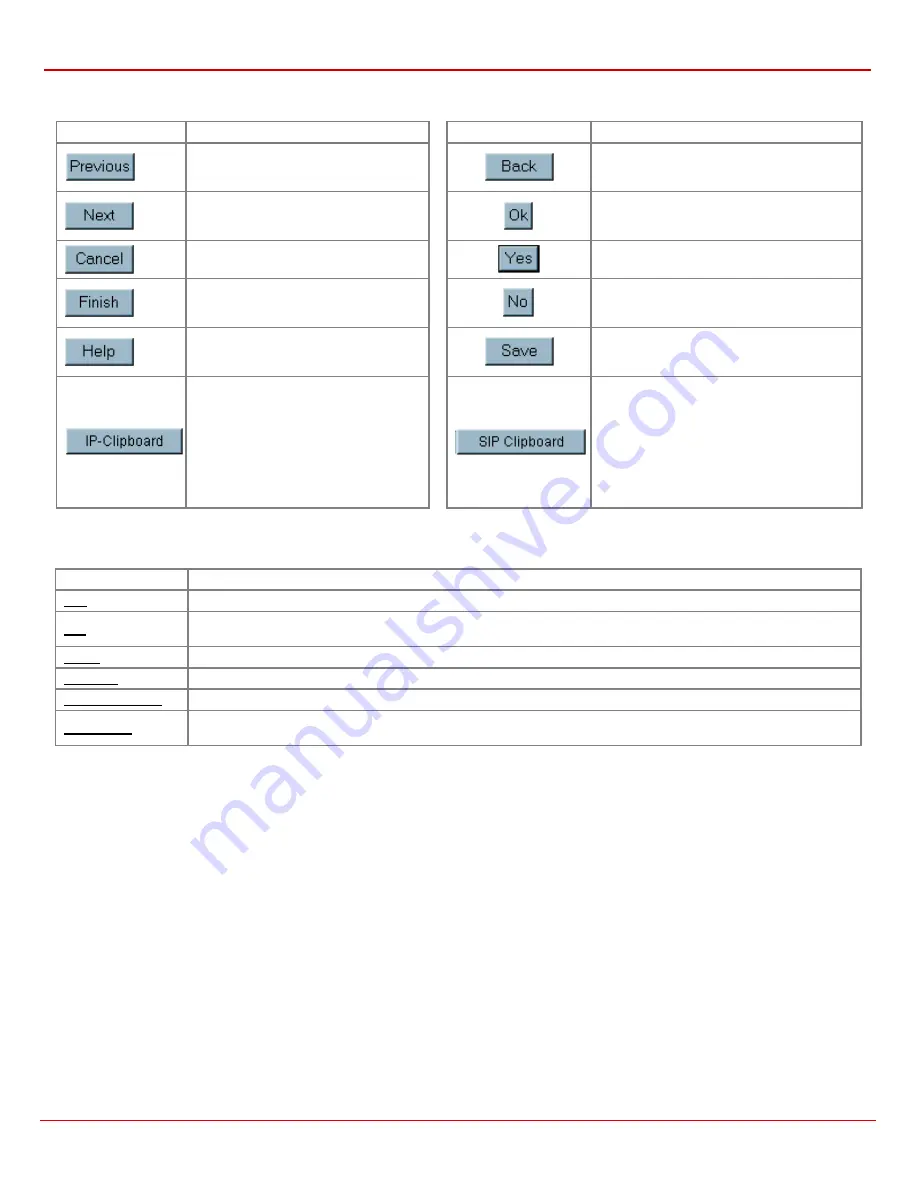
QuadroFXO Manual II: Administrator's Guide
Quadro's Graphical Interface
QuadroFXO (SW Version 3.0.x)
6
Recurrent Buttons
Button Description
Button
Description
This button leads back to the previous
page of a fixed sequence of pages (used
mainly in wizards).
This button leads back to the page you have
been on before.
This button leads onward to the next page
of a fixed sequence of pages (used mainly
in wizards).
This button confirms an operation you started
before.
This button discards the latest, not yet
confirmed entries.
This button confirms an operation you chose
before.
This is the last button of a fixed sequence
of pages that completes and saves the
entries of the whole sequence.
This button discards an operation you chose
before.
This button opens the help page
belonging to the currently active Quadro
management page.
This button saves the settings modified on the
currently active management page.
This button opens a window where the last
inserted IP addresses are listed. It is a
kind of clipboard that helps the user to
make quick selection of an IP address in
case it has been already used in the past,
thus to avoid typing it again. The clipboard
can hold up to 10 IP addresses, a new IP
address will replace the oldest one from
the list.
This button opens a window where the last
inserted SIP addresses are listed. It is a kind of
clipboard that helps the user to make quick
selection of a SIP address in case it has been
already used in the past, thus to avoid typing it
again. The clipboard can hold up to 10 SIP
addresses, a new SIP address will replace the
oldest one from the list.
Recurrent Functional Buttons
In connection with tables, the following buttons - among others - usually occur:
Functional Button
Description
Add
Allows adding a new record to the displayed table. A new page will be displayed to enter any new settings.
Edit
Allows modifying the settings of the record selected by its checkbox. Normally only one record may be selected. A new
page will be displayed to enter the modified settings.
Delete
Deletes the selected entry(s) of a table. A warning message will demand a confirmation before deleting an existing entry.
Select All
Selects all table entry(s)for example for further deletion.
Inverse Selection
Inverses an existing selection of table entry(s). If no entries are selected, clicking the button will select all records.
Refresh in...
May occur in the upper right corner of a page. It displays the number of seconds remaining until the next refresh of the page
and it may be used to reload the page manually.
Most of the tables offer the option to sort the entries in ascending or descending order by clicking the headings of the columns. A small arrow beside
the column heading will show the direction of sorting - upward or downward. The entries of the table can be selected by the assigned checkboxes -
one at a time, for the most part - in order to edit or delete them.
Entering a SIP Addresses correctly
Calls over IP are implemented based on Session Initiating Protocol (SIP) on the Quadro. When making a call to a destination that is somewhere on
the Internet, SIP address must be given.
SIP addresses have to be specified in one of the following formats:
“display
name”
<username@ipaddress:port>
“display
name”
<username@ipaddress>
username@ipaddress:port
username@ipaddress
username
The display name and the port number are optional parameters in the
SIP address. If a port is not specified, 5060 will be set up as the default
one. The range of valid ports is between 1024 and 65536.
A flexible structure of wildcards is allowed. In comparison with a
wildcard, the “?” character stands for only one unknown digit and the “*”
character stands for any number of any digits.
Particularly the following combinations can be used for your
convenience:
•
*@ipaddress - any user from the specified SIP server
•
username@* - a specified user from any SIP server
•
*@* - any user from any SIP server
Please Note:
Wildcards are available for caller addresses only. No
wildcard characters are allowed for called party addresses. Exceptions
are addresses in
Supplementary Addresses
table which are used by
Outgoing Call Blocking
service. To use “*” and “?” themselves (as non
wildcard characters), use “\*” and “\?” correspondingly.







































